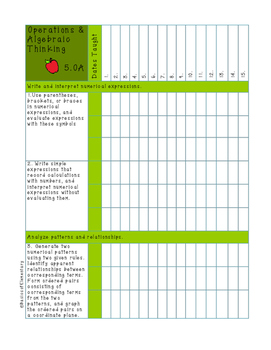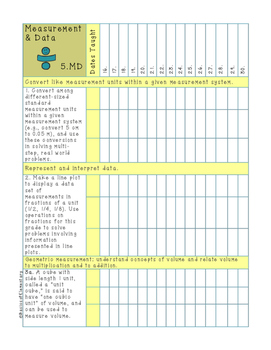*CHEAT SHEET* Student Math Common Core Standards Assessment Checklist!!
Basics of Elementary
31 Followers
Grade Levels
K - 6th, Homeschool
Subjects
Resource Type
Standards
CCSS5.MD.A.1
CCSS5.MD.B.2
CCSS5.MD.C.3
CCSS5.MD.C.3a
CCSS5.MD.C.3b
Formats Included
- PDF
Pages
29 pages
Basics of Elementary
31 Followers
Description
In this age of data driven classroom instruction, I wanted to combine three VERY important resources into an easily accessible and usable assessment document.
I wanted to know WHAT standard was taught, WHEN it was taught, and what the STUDENT LEVEL OF MASTERY was on that particular day it was taught.
This tool would be PERFECT for:
Pre-assessment, formative assessment, and post/summative assessment
Download my *FREE* preview of "Operations &Algebraic Thinking:
HERE!
The document shows all the standards under “Operations & Algebraic Thinking” for the 5th grade and with 3 separate entries of dates for EACH standard for EACH student! It’s concise but powerful!
Be sure to print double-sided so all 30 students can be kept together for each standard!
DOWNLOAD the preview and leave some FEEDBACK love!
I wanted to know WHAT standard was taught, WHEN it was taught, and what the STUDENT LEVEL OF MASTERY was on that particular day it was taught.
This tool would be PERFECT for:
Pre-assessment, formative assessment, and post/summative assessment
Download my *FREE* preview of "Operations &Algebraic Thinking:
HERE!
The document shows all the standards under “Operations & Algebraic Thinking” for the 5th grade and with 3 separate entries of dates for EACH standard for EACH student! It’s concise but powerful!
Be sure to print double-sided so all 30 students can be kept together for each standard!
DOWNLOAD the preview and leave some FEEDBACK love!
Total Pages
29 pages
Answer Key
N/A
Teaching Duration
N/A
Report this resource to TPT
Reported resources will be reviewed by our team. Report this resource to let us know if this resource violates TPT’s content guidelines.
Standards
to see state-specific standards (only available in the US).
CCSS5.MD.A.1
Convert among different-sized standard measurement units within a given measurement system (e.g., convert 5 cm to 0.05 m), and use these conversions in solving multi-step, real world problems.
CCSS5.MD.B.2
Make a line plot to display a data set of measurements in fractions of a unit (1/2, 1/4, 1/8). Use operations on fractions for this grade to solve problems involving information presented in line plots. For example, given different measurements of liquid in identical beakers, find the amount of liquid each beaker would contain if the total amount in all the beakers were redistributed equally.
CCSS5.MD.C.3
Recognize volume as an attribute of solid figures and understand concepts of volume measurement.
CCSS5.MD.C.3a
A cube with side length 1 unit, called a “unit cube,” is said to have “one cubic unit” of volume, and can be used to measure volume.
CCSS5.MD.C.3b
A solid figure which can be packed without gaps or overlaps using 𝘯 unit cubes is said to have a volume of 𝘯 cubic units.





